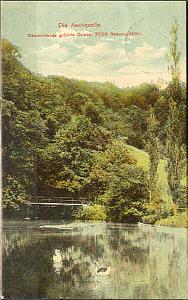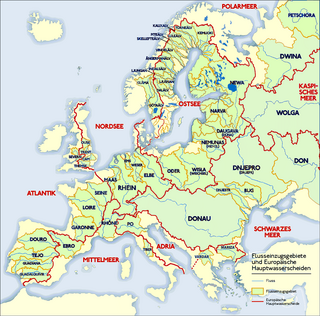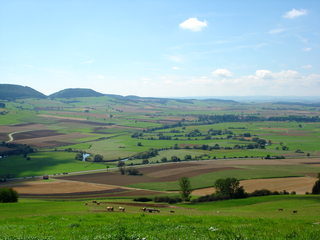
Abnoba is a name with theological and geographical meanings: It is the name of a Gaulish goddess who was worshiped in the Black Forest and surrounding areas. It is also the name of a mountain or mountain range.

The Breg is a river, 46 kilometres long, in Baden-Württemberg, Germany, and the primary headstream of the Danube.

The Brigach is the shorter of two streams that jointly form the river Danube in Baden-Württemberg, Germany. The Brigach has its source at 925 m (3,035 ft) above sea level within St. Georgen in the Black Forest. The Brigach crosses the city Villingen-Schwenningen. 40.4 km (25.1 mi) from the source, the Brigach joins the Breg in Donaueschingen to form the Danube River.

The Aachtopf is Germany's biggest karst spring, south of the western end of the Swabian Jura near the town of Aach. It produces an average of 8,500 litres per second. Most of the water stems from the River Danube where it disappears underground at the Danube Sinkhole, 12 kilometres (7.5 mi) north near Immendingen and about 14 kilometres (8.7 mi) north near Fridingen. The cave system has been explored since the 1960s, but as of 2020 only a small part has been discovered due to a large blockage after a few hundred metres.

Furtwangen im Schwarzwald is a small city located in the Black Forest region of southwestern Germany. Together with Villingen-Schwenningen, Furtwangen is part of the district of Schwarzwald-Baar.

Donaueschingen is a German town in the Black Forest in the southwest of the federal state of Baden-Württemberg in the Schwarzwald-Baar Kreis. It stands near the confluence of the two sources of the river Danube.

The main European watershed is the drainage divide ("watershed") which separates the basins of the rivers that empty into the Atlantic Ocean, the North Sea and the Baltic Sea from those that feed the Mediterranean Sea, the Adriatic Sea and the Black Sea. It stretches from the tip of the Iberian Peninsula at Gibraltar in the southwest to the endorheic basin of the Caspian Sea in Russia in the northeast.

The Elz is a river in Baden-Württemberg, Germany, a right tributary of the Rhine. It rises in the Black Forest, near the source of the Breg. The Elz flows through Elzach, Waldkirch and Emmendingen before reaching the Rhine near Lahr. Its length is approx. 121 km (75 mi).

Sankt Georgen im Schwarzwald is a town in Southwestern Baden-Württemberg, Germany and belongs to Schwarzwald-Baar County.

Hüfingen is a town in the district of Schwarzwald-Baar, in Baden-Württemberg, Germany. It is situated on the river Breg, 4 km south of the source of the Danube.

The Ister is a 2004 documentary film directed by David Barison and Daniel Ross. The film is loosely based on the works of philosopher Martin Heidegger, in particular the 1942 lecture course he delivered, Hölderlins Hymne »Der Ister«, concerning a poem, Der Ister, by the German poet Friedrich Hölderlin. The film had its premiere at the International Film Festival Rotterdam in 2004.

Gütenbach is a municipality in the district of Schwarzwald-Baar in Baden-Württemberg in Germany. It is the home of the Faller toy company.
The Baden Black Forest Railway is a twin-track, electrified railway line in Baden-Württemberg, Germany, running in a NW-SE direction to link Offenburg on the Rhine Valley Railway (Rheintalbahn) with Singen on the High Rhine Railway (Hochrheinbahn). Passing directly across the Black Forest, through spectacular scenery, the route is 150 km long, ascends 650 metres from lowest to highest elevation, and passes through 39 tunnels and over 2 viaducts. It is still the only true mountain railway in Germany to be built with two tracks, and is the most important railway line in the Black Forest. It was built between 1863 and 1873, utilizing plans drawn up by Robert Gerwig.

The Danube is the second-longest river in Europe, after the Volga in Russia. It flows through Central and Southeastern Europe, from the Black Forest south into the Black Sea. A large and historically important river, it was once a frontier of the Roman Empire. In the 21st century, it connects ten European countries, running through their territories or marking a border. Originating in Germany, the Danube flows southeast for 2,850 km (1,770 mi), passing through or bordering Austria, Slovakia, Hungary, Croatia, Serbia, Romania, Bulgaria, Moldova, and Ukraine. Among the many cities on the river are four national capitals: Vienna, Bratislava, Budapest, and Belgrade. Its drainage basin amounts to 817,000 km2 (315,000 sq mi) and extends into nine more countries.

The Baar is a plateau that lies 600 to 900 metres above sea level in southwest Germany. It is part of the Table Jura. It is bordered by the southeastern edge of the Black Forest to the west, the southwestern part of the Swabian Alb known as the Heuberg to the east, and the Randen mountain to the south.

The Stöcklewald is a mountain, 1,068.2 m above sea level (NHN), in the southern part of the Central Black Forest in Germany between the towns of Furtwangen and Triberg, each about 5 kilometres distant, in the county of Schwarzwald-Baar-Kreis. Towards the north, the Black Forest only exceeds this height again in the area of the Schliffkopf and the Hornisgrinde.
Donaubach is a short river in Donaueschingen, Baden-Württemberg, Germany. It flows from the source of the Danube to the Brigach. For much of modern history, it has been considered the source of the Danube river.

The Stille Musel, often just called the Musel by locals, is a small river about 14 km long, which has its source between Mühlhausen near Schwenningen and Hochemmingen at the Türnhalde near the B 523, flows through the Wittmannstal and flows into the Salinensee at Bad Dürrheim. It leaves the Salinensee again, flows through the centre of Bad Dürrheim and further to Donaueschingen, there north of the Schlosspark, where it flows into the Danube from the left shortly after the confluence of Brigach and Breg.

The Ringzug, also called the 3er-Ringzug is a passenger transport network in the districts of Tuttlingen, Rottweil and Schwarzwald-Baar in southern Baden-Württemberg, Germany. The Ringzug went into regular operations on 31 August 2003 and has operated in its current form since 12 December 2004. The concept of the Ringzug is the operation of a clockface timetable, coordinated with a variety of other buses and train services, over an S-Bahn-like network in a rural environment. In March 2006, the passenger association Pro Bahn described the Ringzug as an exemplary public transport system at its 2006-passenger transport awards. The Ringzug has aroused interest beyond the region and can point to steadily rising passenger numbers and declining deficits.



















